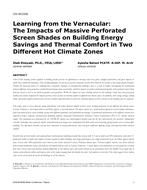Description
Solar-Screen shading systems applied to building facades present an opportunity to manage solar heat gains, daylight penetration, and glare impacts in multi-story commercial buildings. These shading typologies are praised as passive vernacular systems that stood the test of time as low energy design strategies. Despite the increased interest in adopting these vernacular strategies in contemporary buildings, there is a lack of studies investigating the relationship between different screen geometries, perforation percentage, form, materiality, and their impacts on indoor environmental quality of the perimeter spaces from both the visual as well as the thermal qualities and quantities. While the impacts of screen shading systems on the building’s shape have been previously studied, few studies compared the impacts of these screen systems on thermal comfort in different hot climate zones. In addition, their energy savings, cooling loads, and multi-comfort potential have not been studied comprehensively to unveil the combined impacts of these systems on the building and its occupants. This paper aims to assess dynamic energy performance and indoor thermal comfort of three screen shading geometries in two different hot climate zones; Lahore, Pakistan, a hot-humid climate and Doha, Qatar, a hot-arid climate.The paper reports on a multi-method approach research design combining a field assessment of three screen-shading systems with different geometries and perforation percentages. Experimental performance of the different systems were simulated using a dynamic environmental modelling software, Integrated Environments Solutions-Virtual Environment (IES-VE) Apache thermal engine. The simulation was performed for an ASHRAE typical year meteorological weather data for the two representative city locations. Independent variables including screen geometry, depth, and perforation percentages were manipulated for both south and west-facing glazed façades of an existing office building. The dependent variables assessed were reductions in energy performance, solar heat gain coefficient, lighting energy, and improved indoor thermal comfort. Results from our field studies and computational environmental modelling revealed that screens with 3-5 cms in depth and 30% perforation ratio with 1:1 perforation width to depth ratio improve thermal comfort in office buildings and energy performance over larger perforated screens for Doha, Qatar climate zone.Screens with 50% perforation ratio, however, were better suited for Lahore, Pakistan climate zone. Thermal comfort, however, was better achieved with variable perforation ratios, especially for hot-humid climates such as, Lahore, Pakistan. Various degrees of permutations of screen geometries revealed that solar screens voids and patterns perform differently in hot climate zones and results should not be generalized across the Middle East region due to various micro-climates within and between cities of the region ranging from hot-humid, hot-arid, hot-moderate, to hot-dry. This study suggests that, indeed, solar screens of one form do not fit all buildings at all hot climates.
Citation: 2018 Winter Conference, Chicago, IL, Conference Papers
Product Details
- Published:
- 2018
- Number of Pages:
- 8
- Units of Measure:
- Dual
- File Size:
- 1 file , 2 MB
- Product Code(s):
- D-CH-18-C035




